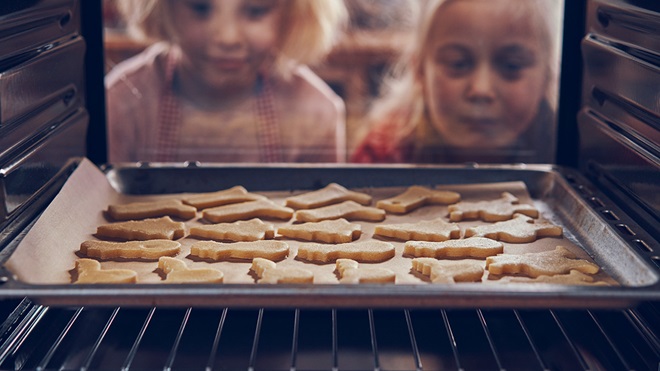Ovens have come a long way in the past two decades, but they're still not entirely foolproof. Human error can definitely play a part in disappointing results when you're baking, roasting or grilling, despite multiple settings and the better heat distribution of modern, fan-forced ovens.
So, if you're finding your cakes are underwhelmingly flat, your roasts are oscillating between dry and underdone, or your vegetables are charring a little too deeply, you might be making a few missteps along the way.
We ask CHOICE home economist Fiona Mair for some oven insights on what we're doing wrong and how to ensure baked perfection every time.
1. You're not preheating properly
Baking is a science, particularly when it comes to cakes and pastries. Fiona says these delicate delights require the oven to be properly hot before they go in, because the ingredients react with the heat to create steam, which enables the cake to rise.
Popping a cake in a cold oven could be disastrous, but it also has an effect on savoury ingredients. Roasts need a blast of heat straight-up to ensure caramelisation and what's called the 'Maillard reaction', which is the chemical process in protein and amino acids that leads to browning and that meaty flavour.
"It is a good idea to get into the habit of turning the oven on once you begin any preparation," says Fiona. As a general rule, it takes about 10 minutes to preheat a fan-forced oven to 200°C, but ovens will differ, so check the manufacturer's instructions for your particular model.
2. You're not keeping it clean
Fiona is a big advocate of wiping down your oven after each use. Yes, it's a pain and most likely the last thing you feel like doing, but hear her out because your future self will thank you. Even a quick wipe down with a microfibre cloth when it comes time to do the dishes will make a difference.
"Cleaning your oven regularly will prevent a smoke-filled kitchen and strong odours transferring to your delicate cakes or wafting through the house," she says. "It also makes cleaning the oven a lot easier if it is wiped out after each time you cook, otherwise, a build-up of residue on the glass will restrict your view while food is cooking."
This last point is important, because…
3. You're taking too many peeks inside
If your oven window is too grimy thanks to a lax approach to the post-roast wipe down, you're going to be tempted to open the oven door to check how your food is going in there.
But every time you open the door, you're letting valuable heat escape. For cakes, this can be the kiss of death. "Cakes and breads are more sensitive to temperature changes, so opening the door at certain stages of baking can be disastrous," says Fiona.
Cleaning the oven is a lot easier if it is wiped out after each time you cook
For other foods that need to be turned, shaken or basted during the cooking, she recommends taking the food out and closing the oven door while you do this. Once the food is manipulated, you can then return it to the oven with minimal heat loss.
4. You're using the wrong settings
New ovens often have multi-functions and cook modes. Make sure you have a thorough read of the manufacturer's instructions before you cook, as they will advise the best modes for cooking certain foods.
As an example, Fiona says: "When cooking on multiple shelves you would use the fan-forced mode, the fan has an element around it so it distributes the heat evenly throughout the cavity.
"But, if you're cooking pizza, you would want the base to be crisp and the top cooked, so you would use the top and bottom element or bottom element and fan forced (pizza mode)."
Have a look at our oven buying guide to read all about the types of functions available.
5. You're using the wrong rack
It might seem inconsequential, but again, science comes into play when using your oven. It's all about heat distribution. Most ovens have about four shelf positions and, by and large, leaving the rack on the middle shelf is fine, as this is where you'll achieve the most even cooking.
But there are some scenarios, such as grilling or baking a pie, where you'll need to change things up, advises Fiona. You grill on the highest shelf for golden tops and bake pies on the bottom shelf to avoid soggy bottoms.

Taking frequent peeks while your oven is cooking away can spell disaster for your cakes and bakes.
6. You're not adjusting settings correctly
If you've bought a new oven and suddenly found your usual classics aren't turning out the way they used to, it could be that you need to adjust your settings. Expect a period of courtship with a new appliance as you get to know it.
"If you have never had a multifunctional oven you will need to familiarise yourself with the different modes and temperatures, especially if cooking all your old favourites," says Fiona.
"Keep in mind fan-forced mode requires a lower temperature than a conventional mode, so you will need to drop the temperature by 20°C."
She says that while you can read the manual, often the only way to get acquainted is through an awkward period of trial and error.
We're on your side
For more than 60 years, we've been making a difference for Australian consumers. In that time, we've never taken ads or sponsorship.
Instead we're funded by members who value expert reviews and independent product testing.
With no self-interest behind our advice, you don't just buy smarter, you get the answers that you need.
You know without hesitation what's safe for you and your family.
And you'll never be alone when something goes wrong or a business treats you unfairly.
Learn more about CHOICE membership today
Stock images: Getty, unless otherwise stated.



